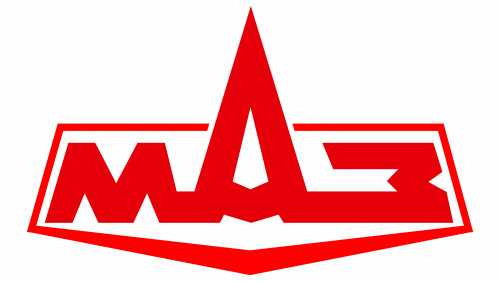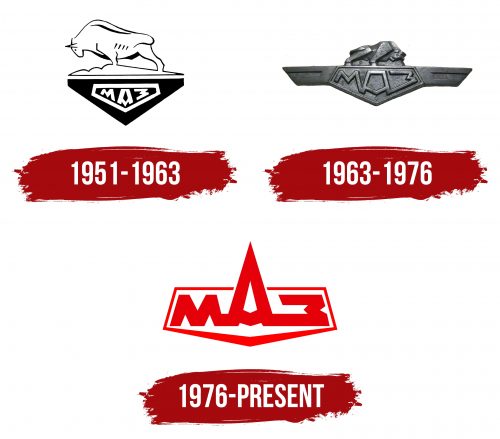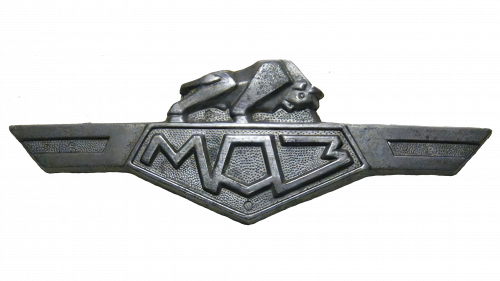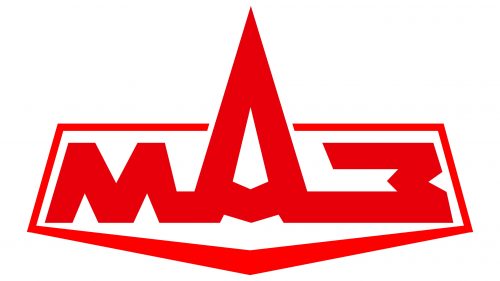The MAZ logo demonstrates the strength of a leader and a winner. Reaching upwards towards the sky, the emblem represents one of the best large equipment manufacturers with worldwide recognition. The symbol highlights the size of the vehicles and hints at the factory’s Soviet past.
MAZ: Brand overview
MAZ (Minsk Automobile Plant), born on July 16, 1944, in the wake of Minsk’s liberation during World War II, is a titan in Belarusian heavy-duty trucks, buses, and special-purpose vehicles. The initial mission focused on repairing and restoring wartime vehicles, laying the foundation for a legacy of innovation and resilience.
The first MAZ truck, the 5-ton MAZ-205 based on the American Studebaker US6, was rolled out in 1947. The 1950s saw an expansion into dump trucks, logging trucks, and other specialized vehicles, solidifying the company’s position as a leading Soviet truck manufacturer. The heavy-duty MAZ-500 series and MAZ-504 tractors from the 1960s were found to be in favor of the Soviet Union and socialist and developing countries.
Growth continued through the 1970s and 1980s, with the introduction of iconic models like the MAZ-5335 and MAZ-5432. These vehicles became essential across various Soviet economic sectors. The company’s repertoire expanded to include specialized equipment for construction and mining, enhancing its industrial footprint.
The dissolution of the Soviet Union in 1991 transformed the company into a state enterprise of independent Belarus. Despite the challenges of a transitioning economy, the company pushed forward, updating its facilities and introducing new models like the MAZ-6430 and MAZ-5440, which met international environmental standards.
The 2000s brought modernization, focusing on producing economical and environmentally friendly trucks and buses that complied with European emission standards. The company’s international reach extended to over 45 countries, spanning the CIS, Middle East, Africa, and Latin America.
Partnerships played a crucial role in the company’s evolution. Collaborations with MAN and Daimler in the 1990s and 2000s led to advanced engine and transmission developments. A joint venture with China’s Weichai Power further boosted engine production capabilities.
Today, the company is one of Eastern Europe’s largest commercial vehicle manufacturers. Embracing new technologies like electric buses and gas-powered vehicles, it continues its tradition of quality and reliability.
Meaning and History
What is MAZ?
MAZ (Minsk Automobile Plant) is a Belarusian company that manufactures heavy-duty vehicles, including trucks, buses, and trailers. MAZ vehicles are known for their durability and reliability, serving various industrial and commercial facilities, especially in Eastern Europe.
1951 – 1963
The first logo of the Minsk Automobile Plant (MAZ) resembles a bumper. The pentagon, balanced on a sharp base, demonstrates impressive stability. The logo shows how a large weight on the top platform maintains balance, highlighting the company’s trucks’ ability to carry heavy loads while keeping a steady path without swerving.
At the top of the logo is a bison, the unofficial symbol of Belarus. This large animal, native to the country, symbolizes strength, endurance, and natural power. These qualities reflect the core characteristics of the company’s trucks, emphasizing their reliability and durability.
The bison’s head is lowered, and its horns are pointed forward, creating an impression of readiness to overcome any obstacle. This stance evokes the powerful dump truck developed in 1950, one of the plant’s iconic products.
The appearance of the Belovezhskaya bison in the plant’s emblem is connected to the decision to use a truck designed in Yaroslavl after American trucks. The emblem of the Yaroslavl truck featured a bear. For Belarus, the bear was replaced with the local bison, adding uniqueness and national identity to the logo.
1963 – 1976
During the reformation of automobile manufacturing in the USSR, the MAZ plant specialized in producing off-road military tractors. The 1963 emblem reflects this military focus. The massive metal bumper emphasizes the strength and durability of the plant’s products.
The company name is elegantly inscribed within a pentagon, with letters changing size to fit the shape. This design choice highlights the ergonomics of the vehicles developed by the plant’s design bureau. MAZ stands for Minsk Automobile Plant, indicating the company’s geographic and industrial origins.
At the center of the emblem is an image of a bull, symbolizing power and strength, qualities inherent in the plant’s vehicles. The bull rests on a stone base that mirrors the contours of its body, underscoring the precision and quality of MAZ vehicle assembly.
1976 – today
In 1976, MAZ stopped using the bison image in its emblem. This change occurred when the plant became part of a joint venture named BelAvtoMAZ. The new logo reflected the unity and synergy of Soviet automotive enterprises.
The unifying symbol for all Soviet companies became the image of the Kremlin and the stars of socialism. The top of the letter “A” rises upward in the emblem, resembling the Kremlin spire, symbolizing the company’s ambition and drive for excellence. The letters of the MAZ name are enclosed in a pentagon, emphasizing the stability and reliability of the products.
The red logo refers to the red banners of the USSR, symbolizing the company’s commitment to socialist ideals and its contribution to the common cause. The emblem highlights the plant’s leadership and significant achievements in the automotive industry.







